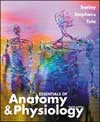 |  Essentials of Anatomy & Physiology, 4/e Rod R. Seeley,
Idaho State University
Philip Tate,
Phoenix College
Trent D. Stephens,
Idaho State University
Feature SummaryAs the amount of information in a textbook increases,
it becomes more and more difficult for students to organize the material in
their minds, determine the main points, and evaluate the progress of their learning.
Above all, the text must be an effective teaching tool. Because each student
may learn best in a different way, a variety of teaching and learning aids is
provided. - Chapter Objectives. Each chapter begins with
a series of learning objectives. The objectives are not a detailed cataloging
of everything to be learned in the chapter; rather, they emphasize the important
facts, topics, and concepts to be covered. The chapter objectives are a conceptual
framework to which additional materials will be added as the chapter is read
in detail.
- Key Terms. All key terms in the chapter are
listed and defined on the chapter opening page. Within the chapter, these
terms are set in boldface for student identification. The terms are also included
in the glossary at the end of the book.
- Vocabulary Aids. Learning anatomy and physiology
is, in many ways, like learning a new language. Basic terminology must be
mastered to communicate effectively. In cases where it is instructionally
valuable, the derivation or origin of key words is given. In their original
language, words are often descriptive, and knowing the original meaning can
often enhance understanding and make it easier to remember the definition
of the word. Common prefixes, suffixes, and combining forms of many biological
terms appear on the inside of the front and back covers of the text and provide
additional information on the derivation of words. When the pronunciation
of a word is complex, a pronunciation guide is included. Simply being able
to pronounce a word correctly is often the key to remembering it. The glossary,
which collects the most important terms into one location for easy reference,
also has a pronunciation guide.
- Did You Know? Did You Know? boxes are designed
to provide relevant and interesting examples to enhance the background of
students who plan to pursue areas related to health. Other examples related
to sports medicine or everyday experiences are included when they reinforce
basic concepts. Did You Know? essays appear right after concepts are presented,
and in so doing, the relevance of the concepts is immediately apparent, helping
the student to better appreciate and understand them.
- Clinical Focus Boxes. These boxed essays are
expanded versions of the Did You Know? boxes that permit more detailed coverage
of a topic. Subjects covered include pathologies, current research, sports
medicine, exercise physiology, pharmacology and clinical applications. They
are designed not only to illustrate the chapter content but also to stimulate
interest.
- Predict Questions. Did You Know? essays and
Clinical Focus boxes can illustrate how a concept works, but a Predict question
requires application of a concept. When reading a text, it is very easy to
become a passive learner; everything seems very clear to passive learners
until they attempt to use the information. The Predict questions convert the
passive learner into an active learner who must use new information to solve
a problem. The answer to this kind of question is not a mere restatement of
a fact, but rather a prediction and analysis of the data, the synthesis of
an experiment, or the evaluation and weighing of important variables of a
problem. For example, "Given a stimulus, predict how a system will respond."
Or, "Given a clinical condition, explain why the observed symptoms occurred."
Answers for the Predict questions are given at the end of each chapter, along
with explanations that demonstrate the process of problem solving.
- Tables. The book contains many tables that have
several uses. They provide more specific information than that included in
the text discussion, allowing the text to concentrate on the general or main
points of a topic. The tables also summarize some aspects of the chapter?s
content, providing a convenient way to find information quickly. Often, a
table is designed to accompany an illustration, so a written description and
a visual presentation are combined to communicate information more effectively.
- Homeostasis Figures. These flow-chart-style
figures provide a summary of the functions of a system and the means by which
that system regulates a parameter within a narrow range of values. Homeostasis
is a major theme of this text, and the homeostasis figures reinforce that
theme effectively. The format of each homeostasis figure in the fourth edition
has been customized to reflect the specific homeostatic mechanism it demonstrates.
- Systems Pathology. These boxes, appearing at
the end of each system chapter, present a modified case study pertaining to
the relevant system. Their goal is to show how each body system is influenced
by the condition described in the case study. A Predict question and a table
identifying how body systems interact in the presence of the profiled condition
follow each Systems Pathology essay.
- Chapter Summary. As the student reads the chapter,
details may obscure the overall picture. The chapter summary is an outline
that briefly states the important facts and concepts and provides a perspective
of the "big picture."
- Content Review Questions. The Content Review
questions are another method used in this text to transform the passive learner
into an active learner. The questions systematically cover the content and
require students to summarize and restate the content in their own words.
- Develop Your Reasoning Skills Questions. Following
mastery of the Content Review questions and therefore chapter content, the
Develop Your Reasoning Skills questions require the application of content
to new situations. These are not essay questions that involve the restatement
or summarization of chapter content. Instead, they provide additional practice
in problem solving and promote the development and acquisition of problem-solving
skills.
|
|



 2002 McGraw-Hill Higher Education
2002 McGraw-Hill Higher Education

 2002 McGraw-Hill Higher Education
2002 McGraw-Hill Higher Education